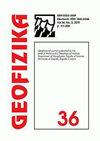Prediction of bed load via suspended sedimentload using soft computing methods
IF 1.1
4区 地球科学
Q4 GEOCHEMISTRY & GEOPHYSICS
引用次数: 21
Abstract
Appropriate and acceptable prediction of bed load being carried by streams is vitally important for water resources quantity and quality studies. Although measuring the rate of bed load in situ is the most consistent method, it is very expensive and cannot be conducted for as many streams as the measurement of suspended sediment load. Therefore, in this study the role of suspended load on bedload prediction was examined by using sensitivity analysis. On the other hand, conventional sediment rating curves and equations can not predict sediment load accurately so recently the usage of machine learning algorithms increase rapidly. Accordingly, soft computational methods are used in the study. These are; artificial neural network (ANN), support vector machine (SVM) models and a decision tree (CHAID) model that is not used before in sediment studies. Some particular parameters are frequently used in these soft computational methods to form input sets. Hence, well known and commonly used three input sets and a new generated set are used as inputs to predict bedload and then the suspended load variable is added in these input sets. The performances of models with respect to input sets are compared to each other. To generate the results and to push the limits of models a very skewed and heterogeneous data is collected from distributed locations. The results indicate that the performance of ANN and CHAID tree models are good when compared to SVM models. The usage of a suspended load as an additional input for the models boosts the model performances and the suspended load has significant contributions to all models.用软计算方法通过悬移泥沙预测河床荷载
适当和可接受的河床负荷预测对水资源数量和质量研究至关重要。虽然就地测量床载速率是最一致的方法,但它非常昂贵,并且不能像测量悬沙负荷那样对许多河流进行测量。因此,本研究采用敏感性分析的方法,对悬移荷载在层载预测中的作用进行了检验。另一方面,传统的泥沙等级曲线和方程不能准确地预测泥沙负荷,因此近年来机器学习算法的使用迅速增加。因此,研究中采用了软计算方法。这些都是;人工神经网络(ANN)、支持向量机(SVM)模型和决策树(CHAID)模型,这些模型在沉积物研究中从未使用过。在这些软计算方法中,经常使用一些特定的参数来形成输入集。因此,采用已知和常用的三个输入集和一个新生成的输入集作为预测河床负荷的输入,然后在这些输入集中加入悬载变量。模型相对于输入集的性能相互比较。为了生成结果并推动模型的极限,从分布的位置收集了非常倾斜和异构的数据。结果表明,与支持向量机模型相比,人工神经网络和CHAID树模型具有较好的性能。使用悬挂负载作为模型的附加输入提高了模型的性能,并且悬挂负载对所有模型都有重要的贡献。
本文章由计算机程序翻译,如有差异,请以英文原文为准。
求助全文
约1分钟内获得全文
求助全文
来源期刊

Geofizika
地学-地球化学与地球物理
CiteScore
1.60
自引率
0.00%
发文量
17
审稿时长
>12 weeks
期刊介绍:
The Geofizika journal succeeds the Papers series (Radovi), which has been published since 1923 at the Geophysical Institute in Zagreb (current the Department of Geophysics, Faculty of Science, University of Zagreb).
Geofizika publishes contributions dealing with physics of the atmosphere, the sea and the Earth''s interior.
 求助内容:
求助内容: 应助结果提醒方式:
应助结果提醒方式:


